Specialist Tips for Preserving and Calibrating Your Tachometer
Specialist Tips for Preserving and Calibrating Your Tachometer
Blog Article
The Significance of a Tachometer in Keeping Track Of Engine Rate and Performance in Automotive Applications
In the world of automobile engineering, the tachometer stands as a crucial instrument in the driver's collection, providing a straight window right into the inner operations of an automobile's engine. Past its feature as a simple gauge of changes per min (RPM), the tachometer functions as a crucial tool for fanatics and experts alike, providing real-time understandings right into engine performance and wellness. Recognizing the significance of this tool surpasses surface-level observations, diving right into the intricate partnership in between engine rate, power output, and general driving experience. As we check out the diverse duty of the tachometer in automotive applications, a much deeper admiration for its effect on lorry dynamics and efficiency starts to arise.
Relevance of Keeping An Eye On Engine RPM
Keeping track of engine RPM, or transformations per minute, is a crucial aspect of auto upkeep and performance assessment. Engine RPM straight correlates with the speed at which the engine's crankshaft turns, suggesting how rapidly the engine is running.
Moreover, checking engine RPM is necessary for performance assessment in racing and high-performance cars. In recap, monitoring engine RPM is not only essential for spotting problems but likewise for enhancing engine efficiency in various automotive applications.

Advantages of Real-Time Data
In auto applications, real-time data plays an important function in giving immediate understandings right into the performance and condition of the automobile. By continuously keeping track of numerous parameters such as engine rate, temperature, fuel usage, and extra, real-time data provides many advantages that add to improved effectiveness and safety and security when traveling.
One substantial benefit of real-time data is its ability to alert chauffeurs and technicians to any type of abnormalities or concerns without delay. This positive technique allows quick identification of potential troubles, allowing for prompt interventions to avoid more damages or failures. In addition, real-time data facilitates efficiency optimization by giving prompt feedback on driving routines and engine effectiveness. Vehicle drivers can change their behavior in real-time based upon this info to accomplish far better gas economy and lengthen the life-span of their lorry.

Furthermore, real-time information plays an important function in contemporary vehicle diagnostics, allowing service technicians to swiftly diagnose and deal with malfunctions. This results in reduced downtime, reduced maintenance expenses, and inevitably, enhanced overall car dependability and durability (tachometer). By harnessing the power of real-time information, automotive stakeholders can make educated decisions that favorably impact both the efficiency and long life of the car
Effect On Gear Shifts
Reliable equipment changes in automotive applications significantly influence total performance and driving experience. The tachometer plays a vital role in enhancing gear shifts by supplying real-time engine rate information to the vehicle driver. When coming close to the redline on the tachometer, it indicates the driver to upshift to stop over-revving the engine and causing possible damage. On the other hand, downshifting at the right moment can assist preserve the engine in its power band, guaranteeing receptive velocity when required.
Moreover, the tachometer aids in accomplishing smoother gear transitions, particularly in manual transmissions. By monitoring engine speed, drivers can implement gear changes at the ideal RPM variety, minimizing snagging motions and decreasing wear on the transmission components. This precision on duty adjustments not just improves driving convenience however also adds to fuel performance.
Enhancing Fuel Effectiveness
Provided the vital duty the tachometer plays in maximizing equipment shifts for performance and engine wellness, it directly adds to optimizing gas efficiency in vehicle applications. By giving real-time feedback on engine speed, the tachometer aids chauffeurs in preserving the most efficient RPM range for gas economy. When motorists regularly keep an eye on the tachometer and change their driving habits accordingly, they can avoid unnecessary gas intake brought on by over-revving or carrying the engine.
Additionally, the tachometer helps vehicle drivers identify the most fuel-efficient gear to be in at any kind of given moment, avoiding the why not find out more engine from working tougher than essential. This is especially essential throughout velocity and his explanation travelling, where remaining in the ideal equipment can considerably affect fuel effectiveness. Furthermore, the tachometer can signal drivers to prospective mechanical problems that might be negatively affecting gas economic situation, such as a sliding clutch or a stopped up air filter. In final thought, the tachometer works as a valuable device in boosting gas efficiency by promoting optimum driving habits and determining areas for renovation in the lorry's efficiency.

Making Best Use Of Engine Long Life
The tachometer's function in monitoring engine rate and performance contributes in making certain the longevity of auto engines. By using the tachometer efficiently, vehicle drivers can enhance engine long life with conscious RPM management. Continually revving an engine too expensive can bring about extreme wear and tear on crucial parts, such as the pistons, valves, and bearings. With time, this can lead to decreased engine efficiency and prospective breakdowns. Monitoring the tachometer permits drivers to remain within the recommended RPM variety for their lorry, preventing unnecessary stress on the engine and extending its life expectancy.

Final Thought
Finally, the tachometer plays a vital function in checking engine speed and performance in automobile applications. By providing real-time data on RPM, it permits reliable equipment changes, enhanced fuel performance, and maximized engine durability. This device is essential for keeping optimum engine efficiency and guaranteeing the overall functionality of a vehicle.
Report this page